Aquarium fern: types, selection, maintenance and breeding

Aquariums are in great demand in the design of residential, public and office spaces. In addition to marine fauna, they may contain a variety of plants. Among them, it is worth highlighting the ferns, notable for their species diversity.

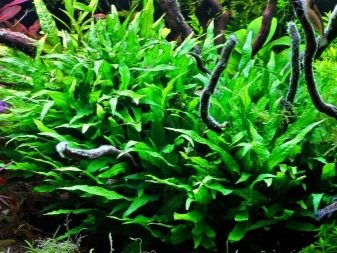
Peculiarities
The stereotype that an aquarium is intended only for keeping fish has long outlived its usefulness, therefore, in addition to marine life, various plants are actively grown in them - with or without aquatic pets. Among them, quite unpretentious and aesthetically attractive ferns stand out, presented in a wide variety of species.
A feature of these crops is their attitude to spore plants, which thrive in almost any climate, as well as in closed reservoirs. Aquarium fern can be grown in conditions close to natural, using various driftwood, to which the culture is easily attached. And also they feel great just in the water. The aquatic fern species are composed of roots, stems and leaves and are mostly similar to each other.
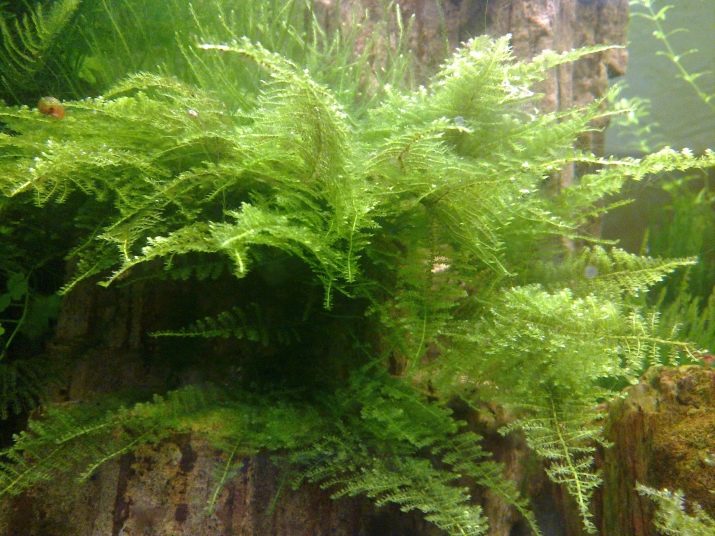
There are some differences in appearance and content.
Such plants in reservoirs with aquatic inhabitants serve not only for decoration, but also to create comfortable conditions, thanks to which fish, snails or other "owners" of the aquarium feel safe.
Plants also act as an additional source of oxygen, and for some inhabitants, a source of food. In addition, crops of this species act as a natural fluid purifier of harmful constituents that adversely affect marine life. But these versatile, useful and attractive crops are not suitable for joint keeping with all fish.

For example, ferns do not root in containers with individuals that prefer to bury themselves in the muddy bottom for shelter or hunting.
As a result of such actions, the underground part of the plant is damaged, and more often it is simply dug out of the ground.
Most of the ferns for aquariums are plants that are many millions of years old, but there are options that breeders have bred only recently.
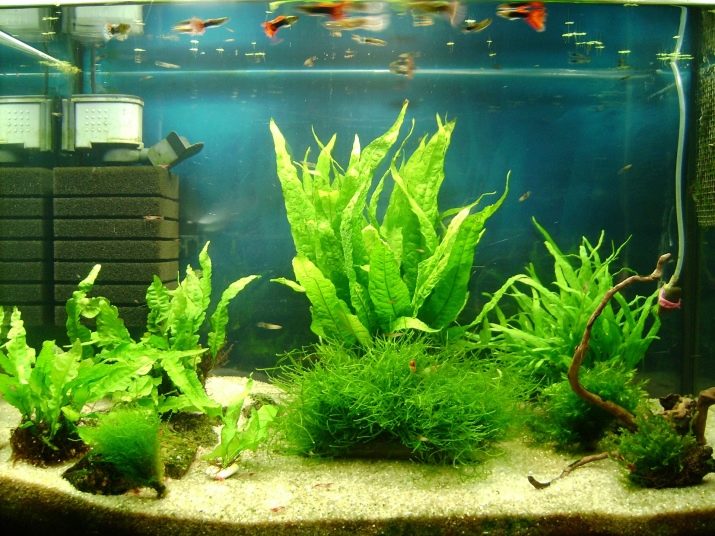
Varieties
Today, the species diversity of cultures is striking in its number. Among aquariums, the following options are more popular.
Thailand vindelova
An unpretentious plant in terms of care and maintenance, belonging to the aquatic group and decorated with lanceolate foliage. Due to the large size of the leaves, which can reach 20 centimeters, the culture in the tank looks quite voluminous and impressive.
They prefer to root such a plant near the main wall of the container or in the very center.
It is rarely used as the only culture in an aquarium. As a rule, green hedges are made from ferns of this species.

Thailand angustifolia
The culture has some visual similarity with the previous representative of spore plants; it is used to decorate small tanks, as well as large-capacity containers. It is this option that is most in demand among aquarists.
The foliage of the plant is painted in a rich green color, but, unlike the Windelov fern, the foliage of the lanceolate type will be narrow.
This plant will also grow in height up to 15-20 centimeters. Leaves develop at an angle. The plant can be used as a group composition or as an independent crop.
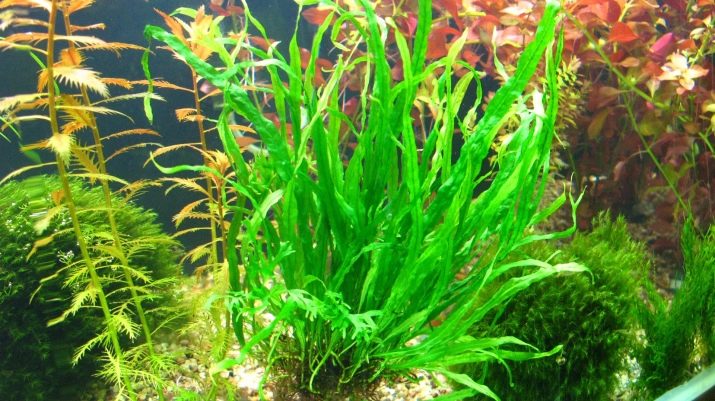
Indian
The second name of the culture is ceratopteris (horn fern). A tropical culture that is found in all latitudes with a warm subtropical climate, in addition, it grows well in closed conditions, therefore it is very often present in aquariums.
In such a fern, according to the descriptions, foliage develops quite magnificently, the leaves themselves are small, painted in a light color, the aerial part is similar in appearance to dill, sometimes you can find species with lacy foliage.
Very often crops are placed together or close to snags. Plants are light-loving, the root system is very small, the culture can grow up to 50 centimeters.
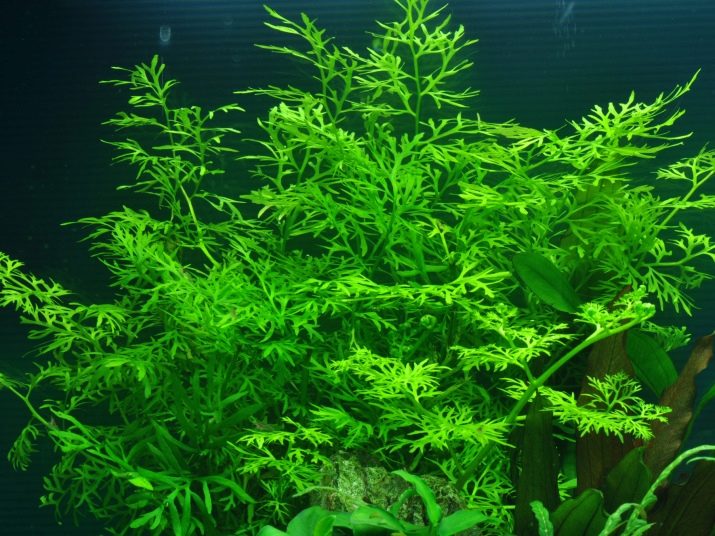
Pterygoid
In everyday life, there is a second name for the plant - water cabbage. In its natural environment, such a fern, as a rule, is located on the surface of the water, however, in closed tanks, this species can be successfully grown in the ground. The culture can grow up to a 30 cm mark. It has rather large foliage, there are cuts at the edges, and the root system is branched.
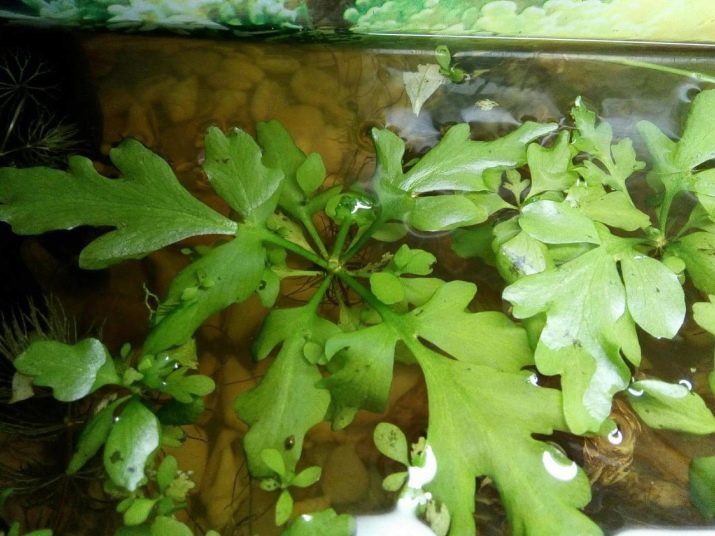
Bolbitis Gedeloti
African fern, which develops extremely slowly, but can grow up to 50–70 centimeters. The foliage is dense, the shape of the leaves is similar to that of oak, the root system is thick. Such a culture is distinguished by its high cost, however, it is very popular among aquarists for its decorative appeal.
Most often, the culture is placed in the background in tanks, therefore, in the process of their growth, the effect of a dense forest is formed inside.
The fern belongs to the light-loving varieties and is remarkable for its ability to easily root on a snag or stone. In the aquarium, it can be almost completely submerged in water.

Lomariopsis
A fern species that does not stand out for its regular shapes has dark green foliage with rounded edges.In its natural environment, the plant can be found in America, China or Africa.
The fern is usually rooted in porous soil or grown on driftwood.
This kind refers to floating varieties of ornamental plants for the aquarium, since it is able to independently rise from the bottom with an increase in the amount of liquid or with the help of a current. Most often, such a culture is planted in small tanks.
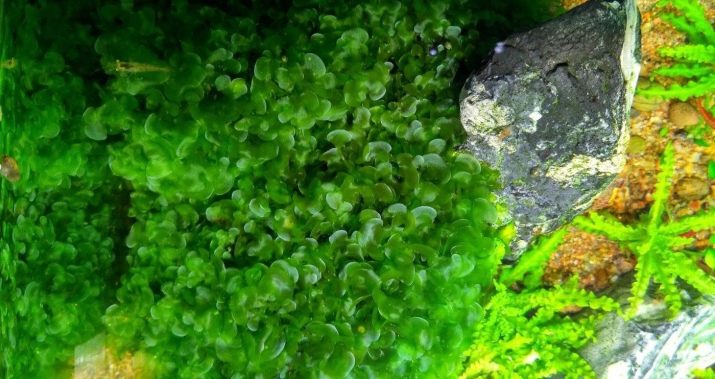
Azolla
Another representative of floating fern crops. There are some similarities with moss. The culture does not stand out for its large size; in the wild, it is found in swampy areas, as well as in slow-flowing bodies of water. The fern root system will be completely in the water, while the upper part can be freely located on its surface. The leaves outwardly resemble small scales.
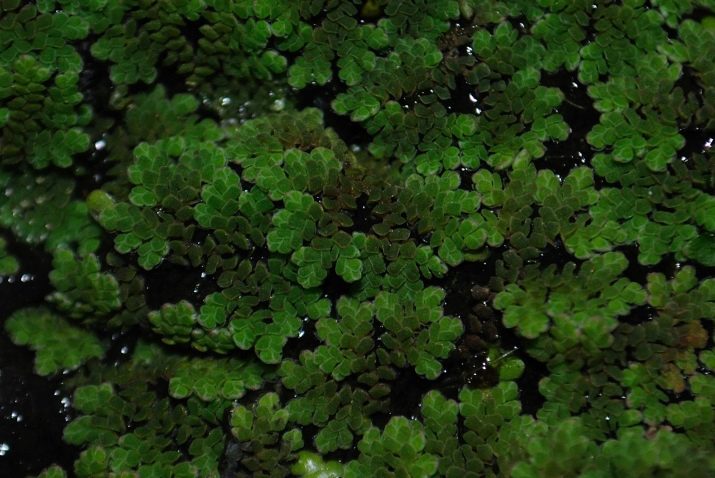
How to choose?
To create a beautiful and correct composition of ferns in the aquarium, you must adhere to the following recommendations.
- It is more correct to select crops of the same variety, so that the vegetation stands out for its quantity, and not for its varietal diversity. This is due to the different requirements of cultures for the content, as well as features related to compatibility with marine life.
- If you plan to place a composition from tropical crops, then the varieties should be selected taking into account their needs for additional fertilizing, the lighting conditions of the tank, as well as the water temperature.
- For placement in the foreground, it is recommended to opt for crops that will not grow too much, obstructing the view. It is best that their height does not exceed 15 centimeters.
- For the central plan, it is most correct to consider spore crops, which will have a high stem. Among these options there are bush-type plants and stand-alone plants, which you should pay attention to when buying. The first option will need space over time and as it grows, in addition, it can become an obstacle on the way to access to the lighting reservoir, which does not always have a positive effect on the health of its inhabitants.
- Background plants can be large, with massive stems and foliage. However, they are best rooted near side windows. Experienced aquarists recommend keeping at least one such plant in their tank, as these crops are considered excellent oxygen suppliers. In addition, they are good at picking up nitrates.
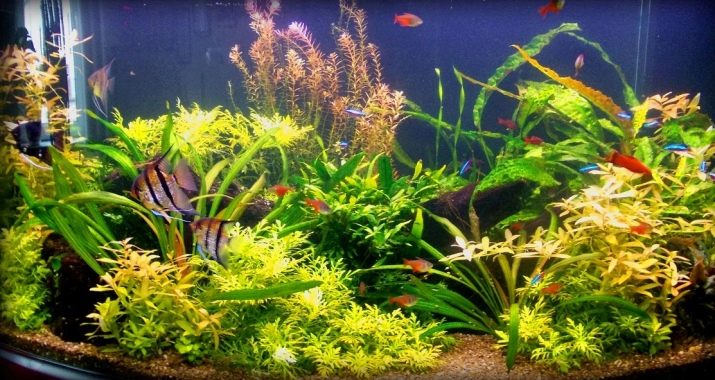
How to plant?
Rooting a fern won't be a problem even for a beginner. For planting, it is worth choosing the preferred placement option based on the characteristics of a particular type. However, most of the crops can be safely planted in a special substrate or placed in sandy soil, near stones, on snags in an aquarium.
The presence of soil will help the young plant to gain a foothold on the surface, as well as adapt to the new habitat. Since ferns are plants that reproduce vegetatively, sometimes a plant can root on its own with the help of individual daughter leaves.
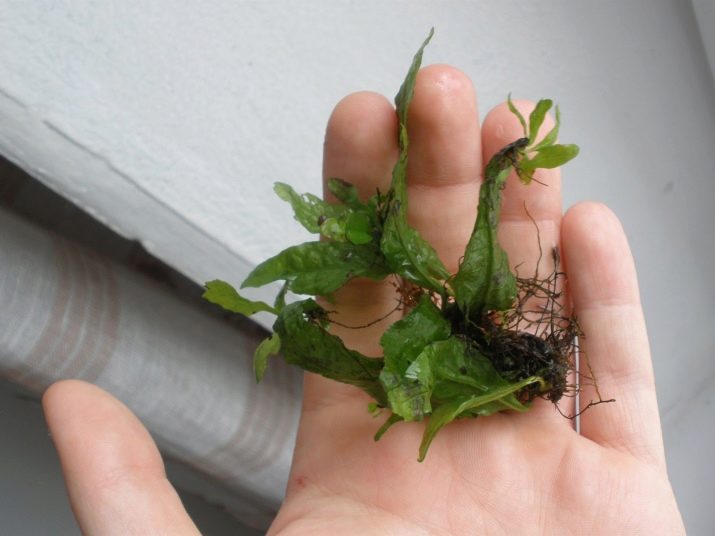
As a rule, such parts will float on the surface until the root system appears, after which the culture will independently sink to the bottom and anchor in the ground.
To plant a plant on a rock or driftwood in an aquarium, you can use fishing line or nylon thread, with the help of which the small plant will need to be fixed. It is also allowed to use medical super glue.
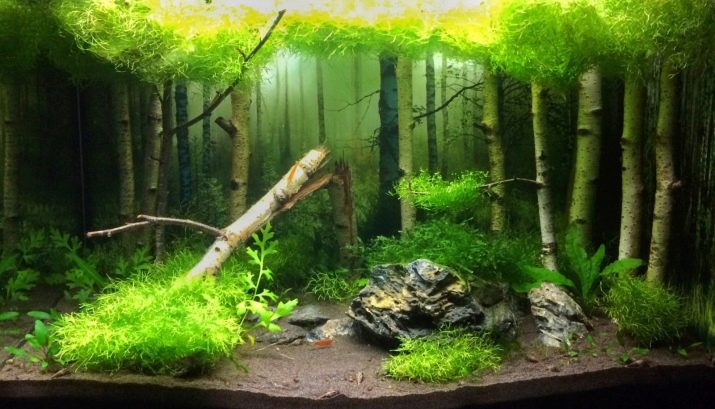
Content rules
In order for the fern to grow and develop in the aquarium, he needs to provide the right conditions in a closed environment.
- As for the liquid, soft water of slightly acidic or neutral composition will be suitable for the culture. The hardness should be maintained at 6 dGH, while the acidity should be at 5-6 pH.
- It is also important to maintain a constant water temperature. The optimal values for fern will be values in the range from 20 to 24 degrees.
- Changing part of the liquid in the aquarium is a mandatory requirement not only for marine life, but also for plants. For tropical crops, you will need to change at least a third of the liquid from the total volume once a week.
- Despite the fact that plants themselves act as a natural filter, additional water purification will not interfere with them. That is why it is recommended for the aquarist to place a filter in the container and also to monitor the appropriate aeration of the liquid.
- A significant part of ferns belongs to light-loving crops, the presence of good lighting allows them to develop and increase in size correctly. Daylight hours for them should last at least 12 hours, even in winter. For these purposes, fluorescent lamps are usually used.
- Crops have a positive attitude towards the introduction of additional fertilizers. In order for the plants to grow actively, fern urea may be added to the water. For 100 liters of water, it will be enough to use 1 or 2 feeding granules per week.

How to reproduce?
A vegetative way of getting new plants, as well as reproduction with the help of spores, are two options for getting a new culture. To increase the number of plants in the aquarium, you can separate parts from them, choosing the strongest and most developed culture. However, the new fern must contain a small portion of the rhizome in order to develop further. The green mass on crops forms rather quickly.
In addition, a new plant can be obtained using spores, but on condition that males and females grow side by side in the aquarium.
Fertilization will take place in the liquid in the crops, as a result of which new plants will soon appear in the container.
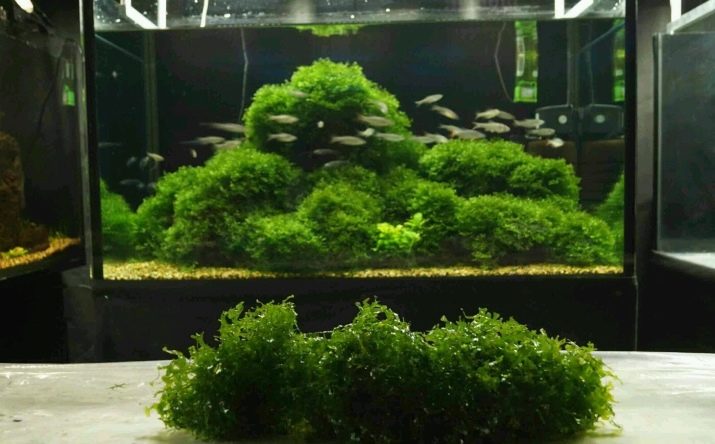
Possible problems
Most often, aquarium cultures suffer from the improper condition of water and soil, which is fraught with a lack of macro- and microelements important for growth. Signs of illness:
- leaves turn black;
- the green mass decreases in size;
- the fern grows very slowly;
- the appearance of yellow streaks.
To restore the balance of the necessary trace elements, you will need to adjust the acidity of the liquid, as well as additionally use fertilizing for aquarium plants.
See below for aquarium fern.








